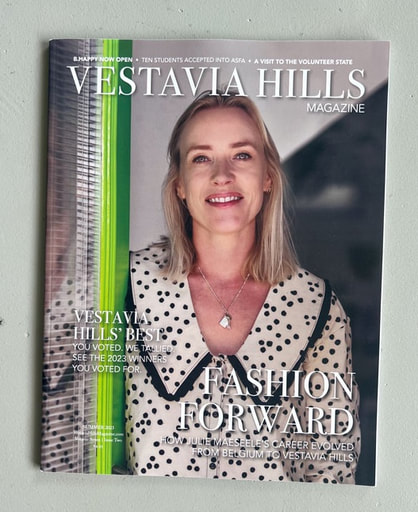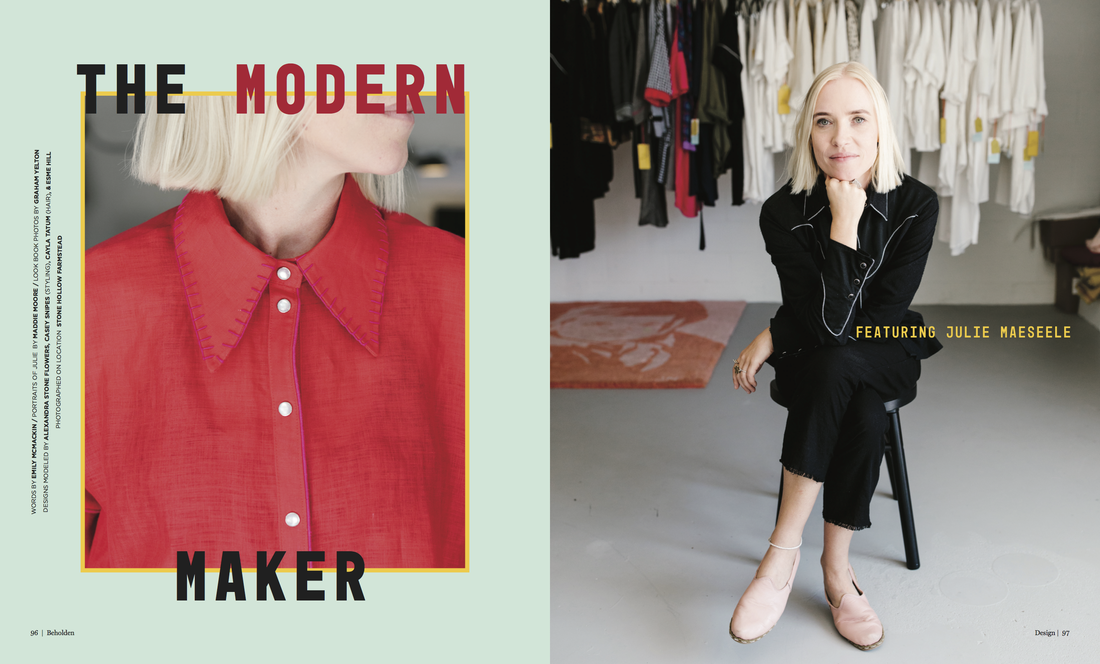Create Birmingham
Nov 2018
I CREATE BIRMINGHAM: JULIE MAESEELE
November 29th, 2018
“The clothes I make are handmade, but the fact is all the clothes we buy are handmade by someone. Maybe that someone is a mother in Bangladesh earning only three dollars a week, and that’s why your shirt is able to cost twenty bucks. I didn’t really understand the value of all the work it takes to craft well-made clothing until I began doing it myself.“
Julie Maeseele (Mah-see-lah) is as sunny, chic, and welcoming as the Cahaba Heights studio where the Belgian designer creates artful and impeccably tailored clothing. If you aren’t familiar with her line yet, you will be soon. Julie’s designs are popping up all over social media and in the closets of Birmingham’s fashion-forward residents. The busy mother of three made time to speak with us about her influences, motivation, and why you should rethink your wardrobe.
Julie, how did you get your start in fashion?
Growing up in Belgium, I always wanted to be a fashion designer. However, when it came to choosing a focus in university, I felt insecure and intimidated about stepping into the fashion world. I ultimately earned my master’s degree in textile design and worked in nearly every aspect of that field except for fashion. I got married and became a mother, but there was still a seed of desire to pursue my passion. When my husband was offered a job that would require us to move to the states, I finally felt compelled to make the leap. For me, moving to America was the perfect time and opportunity to follow my dream. I researched Birmingham and learned about Birmingham Fashion Week. I decided it would be my goal to be a featured designer, and I won the BFW 2016 Emerging Designer Competition.
What a testament to your talent and drive! What has helped propel you forward?
My husband is an incredibly supportive partner. After BFA, I wanted to develop my craft and become a better seamstress. I reached out to Manuel Cuevas, a world-renowned couturier, and interned for him in Nashville. I had a one-year-old and a three-year-old at home in Birmingham at the time and would drive up for two days at a time for six months. I could not have done that without my husband’s encouragement and help. We were both devoted to making this happen.
What inspires your designs and who do you design for?
I love clean lines, form, bold touches, and attention to detail. I am inspired by strong women and want to dress them! My goal is to create clothes that are seasonless, timeless, elegant, and transcend “occasions.” A woman needs clothing that exists between athletic wear and formal attire – clothes that look casually polished and appropriate for errands, work, motherhood, and an evening out.
I also love the idea of the “modest fashion” movement. In Belgium, I worked with some Turkish women who dressed conservatively and wore a hijab. They were so beautiful and alluring. Our culture has become desensitized; we are so used to plunging necklines and sky-high hemlines. I’m not sure I will ever design “sexy” clothes, but I try to capture the authenticity, confidence, and sensuality of the women I dress. That is what is sexy to me.
Your vision and mission is part of the “compassionate fashion” movement. Explain what that means and what it means to you.
Compassionate fashion aims to create clothing within the lens of environmental, ethical, and sustainable ideals. There is so much waste in the textile industry. I use a lot of repurposed remnants and quality fabrics that, if properly cared for, will last for decades – a kind of heirloom. I understand that my designs could be considered expensive, but I believe that the amount of time it takes to carefully design, cut, sew, craft and embellish every detail warrants a higher cost. The clothes I make are handmade, but the fact is all the clothes we buy are handmade by someone. Maybe that someone is a mother in Bangladesh earning only three dollars a week, and that’s why your shirt is able to cost twenty bucks. I didn’t really understand the value of all the work it takes to craft well-made clothing until I began doing it myself. My philosophy is to buy once and buy well. I’m definitely a “less is more” kind of person.
Interview by Tonia Trotter
November 29th, 2018
“The clothes I make are handmade, but the fact is all the clothes we buy are handmade by someone. Maybe that someone is a mother in Bangladesh earning only three dollars a week, and that’s why your shirt is able to cost twenty bucks. I didn’t really understand the value of all the work it takes to craft well-made clothing until I began doing it myself.“
Julie Maeseele (Mah-see-lah) is as sunny, chic, and welcoming as the Cahaba Heights studio where the Belgian designer creates artful and impeccably tailored clothing. If you aren’t familiar with her line yet, you will be soon. Julie’s designs are popping up all over social media and in the closets of Birmingham’s fashion-forward residents. The busy mother of three made time to speak with us about her influences, motivation, and why you should rethink your wardrobe.
Julie, how did you get your start in fashion?
Growing up in Belgium, I always wanted to be a fashion designer. However, when it came to choosing a focus in university, I felt insecure and intimidated about stepping into the fashion world. I ultimately earned my master’s degree in textile design and worked in nearly every aspect of that field except for fashion. I got married and became a mother, but there was still a seed of desire to pursue my passion. When my husband was offered a job that would require us to move to the states, I finally felt compelled to make the leap. For me, moving to America was the perfect time and opportunity to follow my dream. I researched Birmingham and learned about Birmingham Fashion Week. I decided it would be my goal to be a featured designer, and I won the BFW 2016 Emerging Designer Competition.
What a testament to your talent and drive! What has helped propel you forward?
My husband is an incredibly supportive partner. After BFA, I wanted to develop my craft and become a better seamstress. I reached out to Manuel Cuevas, a world-renowned couturier, and interned for him in Nashville. I had a one-year-old and a three-year-old at home in Birmingham at the time and would drive up for two days at a time for six months. I could not have done that without my husband’s encouragement and help. We were both devoted to making this happen.
What inspires your designs and who do you design for?
I love clean lines, form, bold touches, and attention to detail. I am inspired by strong women and want to dress them! My goal is to create clothes that are seasonless, timeless, elegant, and transcend “occasions.” A woman needs clothing that exists between athletic wear and formal attire – clothes that look casually polished and appropriate for errands, work, motherhood, and an evening out.
I also love the idea of the “modest fashion” movement. In Belgium, I worked with some Turkish women who dressed conservatively and wore a hijab. They were so beautiful and alluring. Our culture has become desensitized; we are so used to plunging necklines and sky-high hemlines. I’m not sure I will ever design “sexy” clothes, but I try to capture the authenticity, confidence, and sensuality of the women I dress. That is what is sexy to me.
Your vision and mission is part of the “compassionate fashion” movement. Explain what that means and what it means to you.
Compassionate fashion aims to create clothing within the lens of environmental, ethical, and sustainable ideals. There is so much waste in the textile industry. I use a lot of repurposed remnants and quality fabrics that, if properly cared for, will last for decades – a kind of heirloom. I understand that my designs could be considered expensive, but I believe that the amount of time it takes to carefully design, cut, sew, craft and embellish every detail warrants a higher cost. The clothes I make are handmade, but the fact is all the clothes we buy are handmade by someone. Maybe that someone is a mother in Bangladesh earning only three dollars a week, and that’s why your shirt is able to cost twenty bucks. I didn’t really understand the value of all the work it takes to craft well-made clothing until I began doing it myself. My philosophy is to buy once and buy well. I’m definitely a “less is more” kind of person.
Interview by Tonia Trotter


